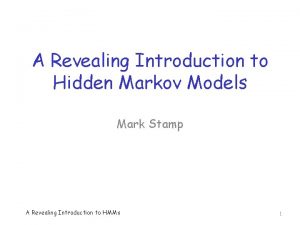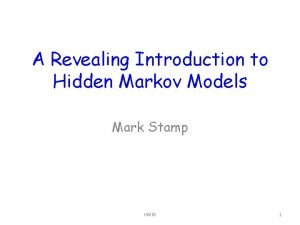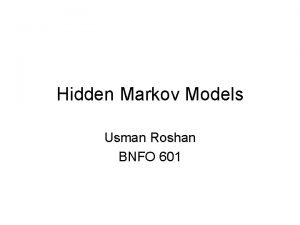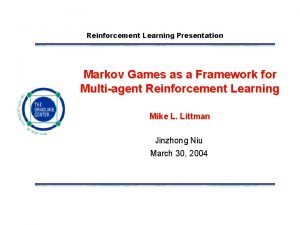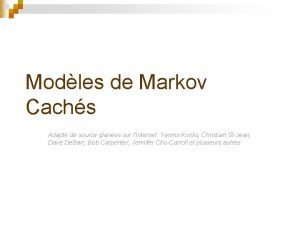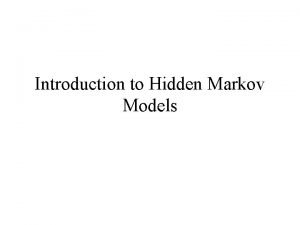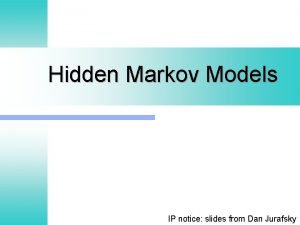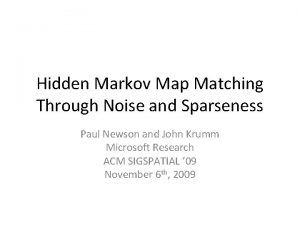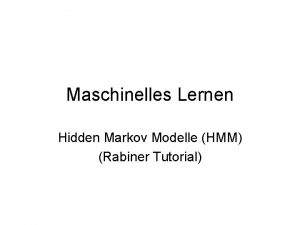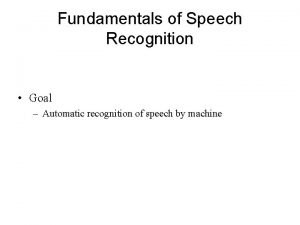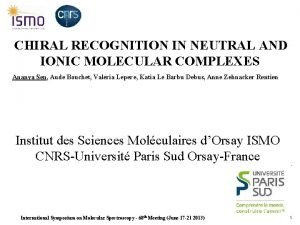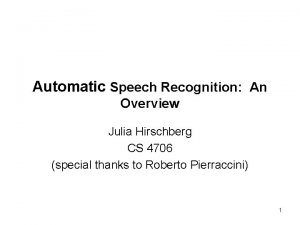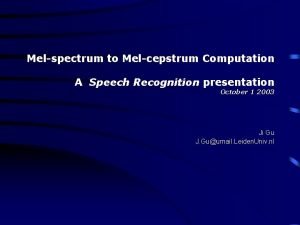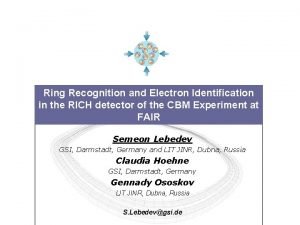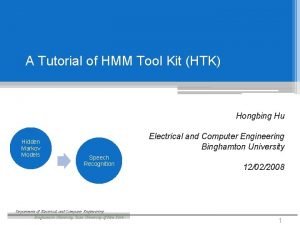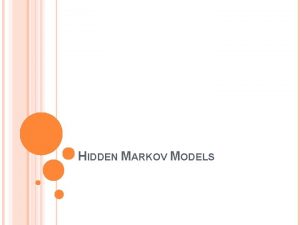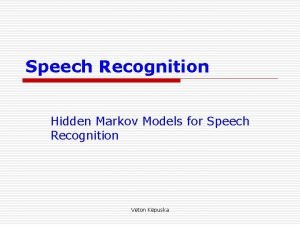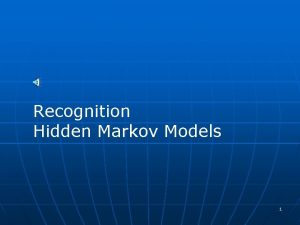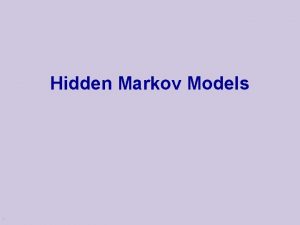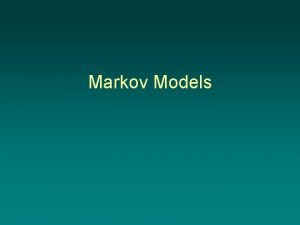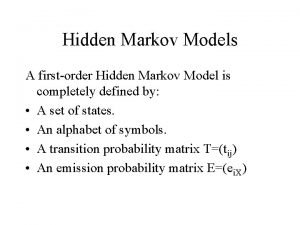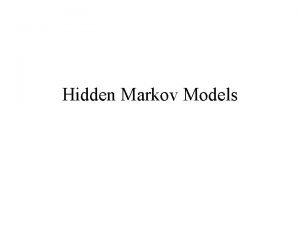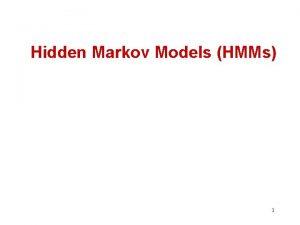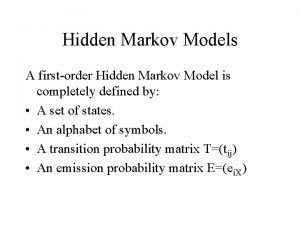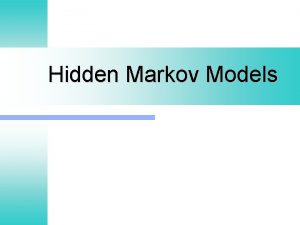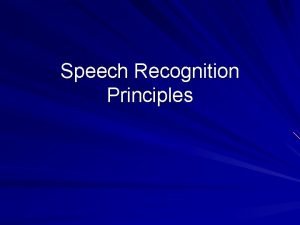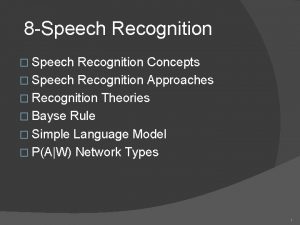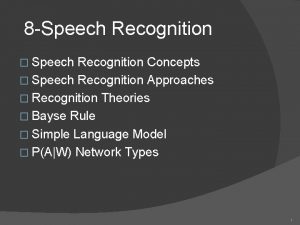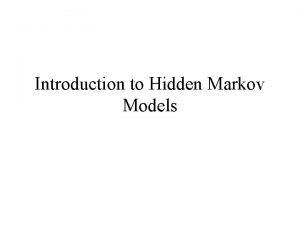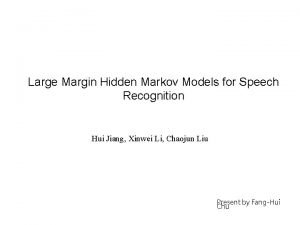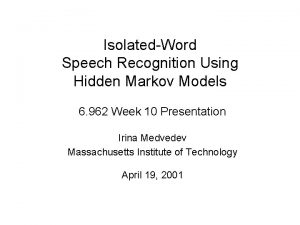CSE 552652 Hidden Markov Models for Speech Recognition





![Expectation-Maximization: Incorporating Hidden Data • Specify a joint-density function [3] (the last term comes Expectation-Maximization: Incorporating Hidden Data • Specify a joint-density function [3] (the last term comes](https://slidetodoc.com/presentation_image_h/f4fee304c2a4056937249138ff71e031/image-6.jpg)




![Expectation-Maximization: EM Step 1 • So, for first step, we want to compute [11] Expectation-Maximization: EM Step 1 • So, for first step, we want to compute [11]](https://slidetodoc.com/presentation_image_h/f4fee304c2a4056937249138ff71e031/image-11.jpg)

![Expectation-Maximization: EM Step 1 • The Q function will therefore be implemented as [14] Expectation-Maximization: EM Step 1 • The Q function will therefore be implemented as [14]](https://slidetodoc.com/presentation_image_h/f4fee304c2a4056937249138ff71e031/image-13.jpg)
![Expectation-Maximization: EM Step 1 • Then the Q function is represented as: [18=15] [19] Expectation-Maximization: EM Step 1 • Then the Q function is represented as: [18=15] [19]](https://slidetodoc.com/presentation_image_h/f4fee304c2a4056937249138ff71e031/image-14.jpg)


![Expectation-Maximization: EM Step 2 • Second term to optimize: [26] • We (again) have Expectation-Maximization: EM Step 2 • Second term to optimize: [26] • We (again) have](https://slidetodoc.com/presentation_image_h/f4fee304c2a4056937249138ff71e031/image-17.jpg)
![Expectation-Maximization: EM Step 2 • Third term to optimize: [28] • Which has the Expectation-Maximization: EM Step 2 • Third term to optimize: [28] • Which has the](https://slidetodoc.com/presentation_image_h/f4fee304c2a4056937249138ff71e031/image-18.jpg)


![Expectation-Maximization: Increasing Likelihood? [34] • Left hand side doesn’t change because it’s not a Expectation-Maximization: Increasing Likelihood? [34] • Left hand side doesn’t change because it’s not a](https://slidetodoc.com/presentation_image_h/f4fee304c2a4056937249138ff71e031/image-21.jpg)

![Expectation-Maximization: Increasing Likelihood? • The right-hand side of this equation [39] is the lower Expectation-Maximization: Increasing Likelihood? • The right-hand side of this equation [39] is the lower](https://slidetodoc.com/presentation_image_h/f4fee304c2a4056937249138ff71e031/image-23.jpg)













- Slides: 36

CSE 552/652 Hidden Markov Models for Speech Recognition Spring, 2005 Oregon Health & Science University OGI School of Science & Engineering John-Paul Hosom Lecture Notes for May 4 Expectation Maximization, Embedded Training

Expectation-Maximization* • We want to compute “good” parameters for an HMM so that when we evaluate it on different utterances, recognition results are accurate. • How do we define or measure “good”? • Important variables are the HMM model , observations O where O = {o 1, o 2, … o. T}, and state sequence S (instead of Q). • The probability density function p(ot | ) is the probability of an observation given the entire model (NOT same as bj(ot)); p(O | ) is the probability of an observation sequence given the model ( ). *These lecture notes are based on: • Bilmes, J. A. , “A Gentle Tutorial of the EM Algorithm and Its Application to Parameter Estimation for Gaussian Mixture and Hidden Markov Models”, ICSI Tech. Report TR-97 -021, 1998. • Zhai, C. X. , “A Note on the Expectation-Maximization (EM) Algorithm, ” CS 397 -CXZ Introduction to Text Information Systems, University of Illinois at Urbana-Champaign, 2003

Expectation-Maximization: Likelihood Functions, “Best” Model • Let’s assume, as usual, that the data vectors ot are independent. • Define the likelihood of a model given a set of observations O: [1] • L( | O) is the likelihood function. It is a function of the model , given a fixed set of data O. If, for two models 1 and 2, the joint probability density p(O | 1) is larger than p(O | 2), then 1 provides a better fit to the data than 2. In this case, we consider 1 to be a “better” model than 2 for the data O. In this case, also, L( 1 | O) > L( 2 | O), and so we can measure the relative goodness of a model by computing its likelihood. • So, to find the “best” model parameters, we want to find the that maximizes the likelihood function: [2]

Expectation-Maximization: Maximizing the Likelihood • This is the “maximum likelihood” approach to obtaining parameters of a model (training). • It is sometimes easier to maximize the log likelihood, log(L( | O)). This will be true in our case. • In some cases (e. g. where the data have the distribution of a single Gaussian), a solution can be obtained directly. • In our case, p(ot | ) is a complicated distribution (depending on several mixtures of Gaussians and an unknown state sequence), and a more complicated solution is used… namely the iterative approach of the Expectation-Maximization (EM) algorithm. • EM is more of a (general) process than a (specific) algorithm; the Baum Welch algorithm (also called the forward-backward algorithm) is a specific implementation of EM.

Expectation-Maximization: Incorporating Hidden Data • Before talking about EM in more detail, we should specifically mention the “hidden” data… • Instead of just O, the observed data, and a model , we also have “hidden” data, the state sequence S. S is “hidden” because we can never know the “true” state sequence that generated a set of observations, we can only compute the most likely state sequence (using Viterbi). • Let’s call the set of complete data (both the observations and the state sequence) Z, where Z = (O, S). • The state sequence S is unknown, but can be expressed as a random variable dependent on the observed data and the model.
![ExpectationMaximization Incorporating Hidden Data Specify a jointdensity function 3 the last term comes Expectation-Maximization: Incorporating Hidden Data • Specify a joint-density function [3] (the last term comes](https://slidetodoc.com/presentation_image_h/f4fee304c2a4056937249138ff71e031/image-6.jpg)
Expectation-Maximization: Incorporating Hidden Data • Specify a joint-density function [3] (the last term comes from the multiplication rule) • The complete-data likelihood function is then [4] • Our goal is then to maximize the expected value of the log-likelihood of this complete likelihood function, and determine the model that yields this maximum likelihood: [5] • We compute the expected value, because the true value can never be known, because S is hidden. We only know probabilities of different state sequences.

Expectation-Maximization: Incorporating Hidden Data • What is the expected value of a function when the p. d. f. of the random variable depends on some other variable(s)? • Expected value of a random variable Y: where is p. d. f. of Y [6] (as specified on slide 6 of Lecture 3) • Expected value of a function h(Y) of the random variable Y: [7] • If the probability density function of Y, f. Y(y), depends on some random variable X, then: [8]

Expectation-Maximization: Overview of EM • First step in EM: Compute the expected value of the complete-data log-likelihood, log(L( | O, S))=log p(O, S | ), with respect to the hidden data S (so we’ll integrate over the space of state sequences S), given the observed data O and previous best model (i-1). • Let’s review the meaning of all these variables: • is some model which we want to evaluate the likelihood of. • O is the observed data (O is known and constant) • i is the index of the current iteration, i = 1, 2, 3, … • (i-1) is a set of parameters of a model from a previous iteration i-1. (for i = 1, (i-1) is the set of initial model values) ( (i-1) is known and constant) • S is a random variable dependent on O and (i-1) with pdf

Expectation-Maximization: Overview of EM • First step in EM: Compute the expected value of the complete-data log-likelihood, log(L( | O, S))=log p(O, S | ), with respect to the hidden data S (so we’ll integrate over the space of state sequences S), given the observed data O and previous best model (i-1). • Q( , (i-1)) is called the function of this expected value: [9]

Expectation-Maximization: Overview of EM • Second step in EM: Find the parameters that maximize the value of Q( , (i-1)). These parameters become the ith value of , to be used in the next iteration [10] • In practice, the expectation and maximization steps are performed simultaneously. • Repeat this expectation-maximization, increasing the value of i at each iteration, until Q( , (i-1)) doesn’t change (or change is below some threshold). • It is guaranteed that with each iteration, the likelihood of will increase or stay the same. (The reasoning for this will follow later in this lecture).
![ExpectationMaximization EM Step 1 So for first step we want to compute 11 Expectation-Maximization: EM Step 1 • So, for first step, we want to compute [11]](https://slidetodoc.com/presentation_image_h/f4fee304c2a4056937249138ff71e031/image-11.jpg)
Expectation-Maximization: EM Step 1 • So, for first step, we want to compute [11] which we can combine with equation 8 [8] to get the expected value with respect to the unknown data S [12] where S is the space of values (state sequences) that s can have.

Expectation-Maximization: EM Step 1 • Problem: We don’t easily know • But, from the multiplication rule, [13] • We do know how to compute • doesn’t change if changes, and so this term has no effect on maximizing the expected value of • So, we can replace and not affect results. with
![ExpectationMaximization EM Step 1 The Q function will therefore be implemented as 14 Expectation-Maximization: EM Step 1 • The Q function will therefore be implemented as [14]](https://slidetodoc.com/presentation_image_h/f4fee304c2a4056937249138ff71e031/image-13.jpg)
Expectation-Maximization: EM Step 1 • The Q function will therefore be implemented as [14] • Since the state sequence is discrete, not continuous, this can be represented as (ignoring constant factors) [15] • Given a specific state sequence s = {q 1, q 2, …q. T}, [16] [17]
![ExpectationMaximization EM Step 1 Then the Q function is represented as 1815 19 Expectation-Maximization: EM Step 1 • Then the Q function is represented as: [18=15] [19]](https://slidetodoc.com/presentation_image_h/f4fee304c2a4056937249138ff71e031/image-14.jpg)
Expectation-Maximization: EM Step 1 • Then the Q function is represented as: [18=15] [19] [20] [21]

Expectation-Maximization: EM Step 2 • If we optimize by finding the parameters at which the derivative of the Q function is zero, we don’t have to actually search over all possible to compute • We can optimize each part independently, since three parameters to be optimized are in three separate terms. We will consider each term separately. • First term to optimize: [22] = [23] because states other than q 1 have a constant effect and so can be omitted (e. g. )

Expectation-Maximization: EM Step 2 • We have the additional constraint that all values sum to 1. 0, so we use a Lagrange multiplier (the usual symbol for the Lagrange multiplier, , is taken), then find the maximum by setting the derivative to 0: [24] • Solution (lots of math left out): [25] • Which equals 1(i) • Which is the same update formula for we saw earlier (Lecture 10, slide 18)
![ExpectationMaximization EM Step 2 Second term to optimize 26 We again have Expectation-Maximization: EM Step 2 • Second term to optimize: [26] • We (again) have](https://slidetodoc.com/presentation_image_h/f4fee304c2a4056937249138ff71e031/image-17.jpg)
Expectation-Maximization: EM Step 2 • Second term to optimize: [26] • We (again) have an additional constraint, namely so we use the Lagrange multiplier , then find the maximum by setting the derivative to 0. • Solution (lots of math left out): [27] • Which is equivalent to the update formula Lecture 10, slide 18.
![ExpectationMaximization EM Step 2 Third term to optimize 28 Which has the Expectation-Maximization: EM Step 2 • Third term to optimize: [28] • Which has the](https://slidetodoc.com/presentation_image_h/f4fee304c2a4056937249138ff71e031/image-18.jpg)
Expectation-Maximization: EM Step 2 • Third term to optimize: [28] • Which has the constraint, in the discrete-HMM case, of there are M discrete events e 1… e. M generated by the HMM • After lots of math, the result is: [29] • Which is equivalent to the update formula Lecture 10, slide 19.

Expectation-Maximization: Increasing Likelihood? • By solving for the point at which the derivative is zero, these solutions find the point at which the Q function (expected log-likelihood of the model ) is at a local maximum, based on a prior model (i-1). • We are maximizing the Q function for each iteration. Is that the same as maximizing the likelihood? • Consider the log-likelihood of a model based on a complete data set, Llog( | O, S), vs. the log-likelihood based on only the observed data O, Llog ( | O): (Llog = log(L)) [30] [31]

Expectation-Maximization: Increasing Likelihood? • Now consider the difference between a new and an old likelihood of the observed data, as a function of the complete data: [32] [33] • If we take the expectation of this difference in log-likelihood with respect to the hidden state sequence S given the observations O and the model (i-1) then we get… (next slide)
![ExpectationMaximization Increasing Likelihood 34 Left hand side doesnt change because its not a Expectation-Maximization: Increasing Likelihood? [34] • Left hand side doesn’t change because it’s not a](https://slidetodoc.com/presentation_image_h/f4fee304c2a4056937249138ff71e031/image-21.jpg)
Expectation-Maximization: Increasing Likelihood? [34] • Left hand side doesn’t change because it’s not a function of S: [35] if p(x) is a probability density function, then so [36]

Expectation-Maximization: Increasing Likelihood? • The third term is the Kullback-Liebler Distance: P(zi), Q(zi) are probability distribution functions [37] (proof involves inequality log(x) x – 1) • So, we have [38] which is the same as [39]
![ExpectationMaximization Increasing Likelihood The righthand side of this equation 39 is the lower Expectation-Maximization: Increasing Likelihood? • The right-hand side of this equation [39] is the lower](https://slidetodoc.com/presentation_image_h/f4fee304c2a4056937249138ff71e031/image-23.jpg)
Expectation-Maximization: Increasing Likelihood? • The right-hand side of this equation [39] is the lower bound on the likelihood function Llog( | O) • By combining [12], [4], and [15] we can write Q as [40] • So, we can re-write Llog( | O) as [41] • Since we have maximized the Q function for model , [42] • And therefore [43]

Expectation-Maximization: Increasing Likelihood? • Therefore, by maximizing the Q function, the log-likelihood of the model given the observations O does increase (or stay the same) with each iteration. • More work is needed to show the solutions for the re-estimation formulae for in the case where bj(ot) is computed from a Gaussian Mixture Model.

Expectation-Maximization: Forward-Backward Algorithm • Because we directly compute the model parameters that maximize the Q function directly, we don’t need to iterate in the Maximization step, and so we can perform both Expectation and Maximization for one iteration simultaneously. • The algorithm is then as follows: (1) get initial model (0) (2) for i = 1 to R: (2 a) use re-estimation formulae to compute parameters of (i) (based on model (i-1)) (2 b) if (i) = (i-1) then break where R is the maximum number of iterations • This is called the forward-backward algorithm because the re-estimation formulae use the variables (which computes probabilities going forward in time) and (which computes probabilities going backward in time).

Expectation-Maximization: Forward-Backward Illustration • Forward-Backward Algorithm, Iteration 1: j , j 0. 5 aij 0. 5 0. 5 bj(ot) μ σ2 ot P(qt=j|O, ) , aij j , j

Expectation-Maximization: Forward-Backward Illustration • Forward-Backward Algorithm, Iteration 2: 0. 94 aij 0. 06 0. 5 0. 91 0. 09 0. 92 0. 08 bj(ot) μ σ2 ot P(qt=j|O, ) , aij j , j

Expectation-Maximization: Forward-Backward Illustration • Forward-Backward Algorithm, Iteration 3: 0. 93 aij 0. 07 0. 53 0. 75 0. 25 0. 47 0. 88 0. 12 0. 93 0. 07 bj(ot) μ σ2 ot P(qt=j|O, ) , aij j , j

Expectation-Maximization: Forward-Backward Illustration • Forward-Backward Algorithm, Iteration 4: 0. 91 aij 0. 08 0. 58 0. 88 0. 12 0. 42 0. 85 0. 15 0. 93 0. 07 bj(ot) μ σ2 ot P(qt=j|O, ) , aij j , j

Expectation-Maximization: Forward-Backward Illustration • Forward-Backward Algorithm, Iteration 10: 0. 89 aij 0. 11 0. 85 0. 87 0. 13 0. 15 0. 78 0. 22 0. 94 0. 06 bj(ot) μ σ2 ot P(qt=j|O, ) , aij j , j

Expectation-Maximization: Forward-Backward Illustration • Forward-Backward Algorithm, Iteration 20: 0. 89 aij 0. 11 0. 84 0. 87 0. 13 0. 16 0. 73 0. 27 0. 94 0. 06 bj(ot) μ σ2 ot P(qt=j|O, ) , aij j , j

Embedded Training • Typically, when training a medium- to large-vocabulary system, each phoneme has its own HMM; these phonemelevel HMMs are then concatenated into a word-level HMM to form the words in the vocabulary. • Typically, forward-backward training is for training the phoneme-level HMMs, and uses a database in which the phonemes have been time-aligned (e. g. TIMIT) so that each phoneme can be trained separately. • The phoneme-level HMMs have been trained to maximize the likelihood of these phoneme models, and so the word-level HMMs created from these phoneme-level HMMs can then be used to then recognize words. • In addition, we can train on sentences (word sequences) in our training corpus using a method called embedded training.

Embedded Training • Initial forward-backward procedure trains on each phoneme individually: y 1 y 2 s 1 y 3 E 1 E 2 s 3 E 3 • Embedded training concatenates all phonemes in a sentence into one sentence-level HMM, then performs forward-backward training on the entire sentence: y 1 y 2 y 3 E 1 E 2 E 3 s 1 s 2 s 3

Embedded Training • Example: Perform embedded training on a sentence from the Resource-Management (RM) corpus: “Show all alerts. ” • First, generate phoneme-level pronunciations for each word • Second, take existing phoneme-level HMMs and concatenate them into one sentence-level HMM. • Third, perform forward-backward training on this sentencelevel HMM. SHOW SH SH OW ALL AA OW OW OW AA AA AA ALERTS L L L AX AX AX L L ER L L TS ER ER ER TS TS TS

Embedded Training • Why do embedded training? (1) Better learning of acoustic characteristics of specific words. (the acoustics of /r/ in “true” and “not rue” are somewhat different, even though the phonetic context is the same) (2) Given initial phoneme-level HMMs trained using forwardbackward, can perform embedded training on much larger corpus of target speech using only the word-level transcription and a pronunciation dictionary. Resulting HMMs are then (a) trained on more data and (b) tuned to specific words in the target corpus. Caution: Words spoken in sentences can have pronunciation that is different from the pronunciation obtained from a dictionary. (Word pronunciation can be context-dependent or speakerdependent).

 A revealing introduction to hidden markov models
A revealing introduction to hidden markov models A revealing introduction to hidden markov models
A revealing introduction to hidden markov models Hidden markov models
Hidden markov models Veton kepuska
Veton kepuska Hidden markov model rock paper scissors
Hidden markov model rock paper scissors Hidden markov model tutorial
Hidden markov model tutorial Hidden markov chain
Hidden markov chain Hidden markov chain
Hidden markov chain Hidden markov map matching through noise and sparseness
Hidden markov map matching through noise and sparseness Rabiner hmm
Rabiner hmm Hidden markov model
Hidden markov model Comparison in figures of speech
Comparison in figures of speech Kinect for windows speech recognition language pack
Kinect for windows speech recognition language pack Fundamentals of speech recognition
Fundamentals of speech recognition Deep learning speech recognition
Deep learning speech recognition Aude leperre
Aude leperre Julia speech recognition
Julia speech recognition Melspectrum
Melspectrum Speech recognition software
Speech recognition software Cmu speech recognition
Cmu speech recognition Speech recognition
Speech recognition Speech recognition app inventor
Speech recognition app inventor Dragon speech recognition
Dragon speech recognition Electron speech recognition
Electron speech recognition Htk speech recognition tutorial
Htk speech recognition tutorial Modal and semi modal verbs
Modal and semi modal verbs Kontinuitetshantering i praktiken
Kontinuitetshantering i praktiken Novell typiska drag
Novell typiska drag Nationell inriktning för artificiell intelligens
Nationell inriktning för artificiell intelligens Vad står k.r.å.k.a.n för
Vad står k.r.å.k.a.n för Shingelfrisyren
Shingelfrisyren En lathund för arbete med kontinuitetshantering
En lathund för arbete med kontinuitetshantering Adressändring ideell förening
Adressändring ideell förening Personlig tidbok fylla i
Personlig tidbok fylla i A gastrica
A gastrica Vad är densitet
Vad är densitet Datorkunskap för nybörjare
Datorkunskap för nybörjare
